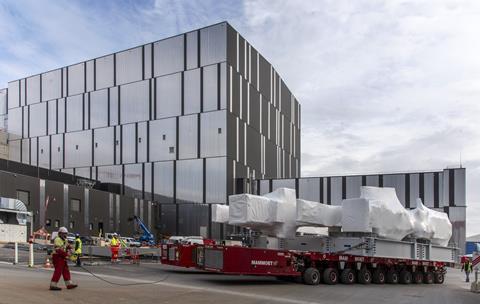Mammoet’s battery powered SPMTs have completed their first jobs at the ITER nuclear fusion research facility in southern France. The equipment is being used to transport heavy components for the construction of the world’s largest tokamak – a device used to prove the feasibility of fusion as a large-scale source of carbon-free energy.

Mammoet is supporting logistics specialist Daher with the transport of key components, including 367-tonne toroidal field coils and 440-tonne vacuum vessel sectors. Two combinations of 12 axle lines of SPMTs powered by an electric power pack unit (ePPU) are being used inside the facility to move the components from storage to the assembly area.
“In July last year, ITER asked if we had an electric power pack available, and at that period it was a time when Mammoet had started to develop a new prototype internally. We explained that we could carry out the necessary steps to have it ready for the beginning of 2024,” said Pascal Taconne, project manager at Mammoet. Over the course of six months, Mammoet performed extensive testing with third parties, while carrying out 100 hours of additional testing using different types of cargo to prove the technology could carry out day-to-day jobs with a full battery.

Mammoet explained that the tokamak needs to be built in a clean environment, where moisture, temperature and particulates are all controlled. In addition to being cleaner and quieter than diesel-powered units, the ePPU can power both lines of SPMTs at once. A major benefit of that is even heavier movements, which require the SPMT combination to work in tandem, can be carried out fully electrically.
Michel Bos, technical specialist at Mammoet, said: “All the things that we have learned building and testing the unit, and adjusting and making it better, have taught us so much about electrifying our equipment. The feeling that heavy movements cannot be done electrically has totally changed in the last year. We are now confident we can work day-to-day jobs easily, creating a more comfortable working environment for operators and supporting zero-emission construction areas. With jobs like ITER, we have proven it works.”
















